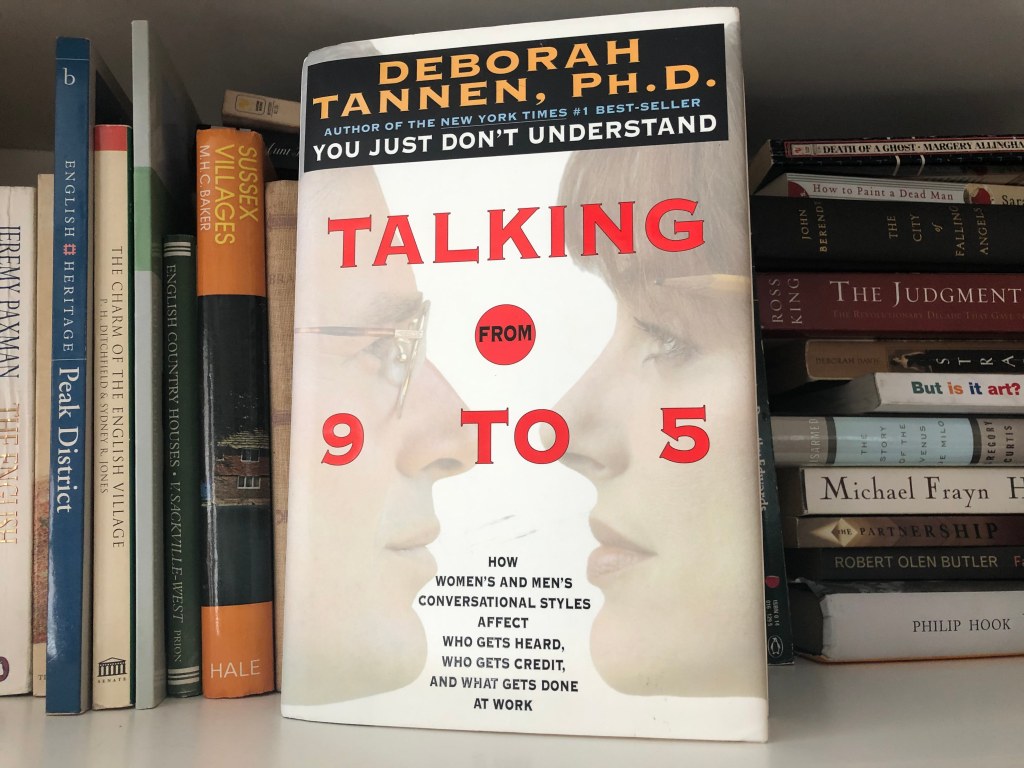
The first book in my feminist January is Talking from 9 to 5: How Women’s and Men’s Conversational Styles Affect Who Gets Heard, Who Gets Credit, and What Gets Done at Work by Deborah Tannen, Ph.D.
This book came out in 1994 and has been on my shelf for ages–not quite since 1994, but for at least five years. I had put off reading it because I don’t love self-help type books, and while I thought it might be useful, I didn’t expect to enjoy it. I WAS SO WRONG. I loved it! Tannen is a linguistics professor, and she draws on extensive research to describe and analyze the differences in the ways men and women typically converse in the workplace.
Before I get into details–Tannen makes abundantly clear that the terms “men’s style” and “women’s style” refer to the typical ways in which men and women in the studies behaved–plenty of men use some aspects of “women’s style” and vice versa, and there is nothing wrong with this. She classifies the styles this way because (even now, over 15 years later) many workplaces are dominated by men, and by men’s communication styles, which means that women (and men who don’t employ the typical male style) are at a disadvantage when styles conflict. She is also upfront about the fact that most studies in the U.S. focus on white, middle-class people in office settings, although she brings in studies of people in other countries and of other races where available.
The major point of this book is that if we understand where other people are coming from when they communicate in certain ways, we can try to avoid misunderstandings. Tannen identifies a fundamental difference in men’s and women’s styles that contributes to these misunderstandings: men’s conversational rituals, based on a lifetime of cultural conditioning, center on getting “one-up” on the other person. In contrast, women’s rituals focus on presenting oneself as “one-down” with the knowledge that the other person recognizes this as a ritual designed to make them comfortable, and the other person therefore does not take advantage but instead returns the gesture, leading to equality in the conversation. This insight alone is worth the time spent reading the book, especially if you, like me, work in a field dominated by the opposite sex.
Unfortunately, I feel like women read these books, and what we really need is for men in male-dominated workplaces to read them. Tannen repeats over and over what women already know–women are penalized for having the female conversational style (because it isn’t seen as confident, etc.) but are also often penalized for switching to a male style (because it is seen as too aggressive and in conflict with men’s cultural expectations for women). Men who have a more typically female style are also penalized.
So many of her examples hit home for me–they could have come straight out of my law firm experience. It might seem redundant to read about something mirroring my own life experience, but I felt reassured that I wasn’t crazy! One section concerns small talk in the workplace, the importance of it, and the way men and women dismiss each other’s respective preferred topics as silly and frivolous. For women in a male-dominated workplace, this means the water-cooler talk always revolves around topics the men want to discuss, but as Tannen says, when women want to join in these discussions, men shut them out–there is no way to win.
Tannen’s style is pleasant, friendly, non-judgmental, and easy to read, as one might expect from a person devoted to the study of conversation and linguistics. Each chapter has multiple sub-sections, which makes this perfect for reading in small chunks and also makes her points easy to follow. No doubt scholars have done much more research on these topics since 1994, but none of the material seems at all dated (somewhat frustratingly–I wish the situation had changed in 15 years!). One section even discusses titles for women and how men tend not to address women entitled to the term “Dr.” as such–I had to laugh, reading this right after the Wall Street Journal op-ed mocking Dr. Jill Biden for using her title. I learned so much from this, not just interesting facts but ways of thinking about communication that I can use in my work life. Highly recommended!!

Hi Carly! Dr. Tanner’s work is classic, a previous book came out in my early days of working—*He Said, She Said*. Sadly not much has changed over the years. Thinking of Kamala to Pence: “I am speaking.” In solidarity, Susan
Sent from my iPhone
>
LikeLiked by 1 person
I definitely want to read more of her work now!
LikeLike